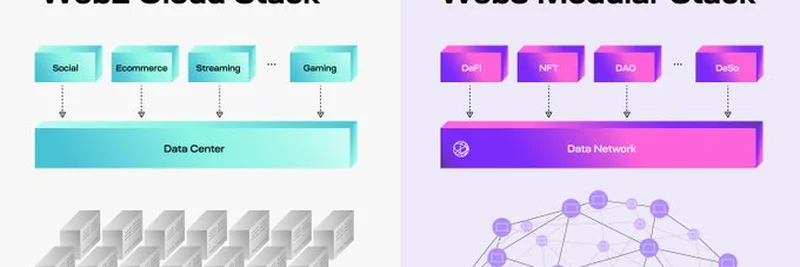Hey there, crypto enthusiasts and blockchain curious! If you’ve been keeping an eye on the latest buzz on X, you might have stumbled across a fascinating thread by Nick White (@nickwh8te) posted on July 24, 2025. In this thread, Nick dives into the evolution from Web2’s centralized data centers to the decentralized data networks powering Web3, spotlighting Celestia as a game-changer. As someone who’s spent years at CoinDesk and now digs into the wild world of meme tokens at meme-insider.com, I’m excited to break this down for you in a way that’s easy to grasp—while sprinkling in some insights for the blockchain pros out there.
The Web2 Way: Centralized Data Centers
Let’s start with what we know. The Web2 stack, as shown in Nick’s image, relies on centralized data centers—think giants like AWS. These are massive hubs where all your social media posts, online shopping sprees, and gaming sessions are stored and processed. The image depicts a neat row of server blocks supporting layers like social platforms, e-commerce, streaming, and gaming. It’s a system that’s worked well for years, but it comes with a catch: everything hinges on a few big players. If one goes down (or gets hacked), the ripple effects can be huge.
Enter Web3: The Decentralized Revolution
Now, flip the coin to Web3. Nick’s thread highlights a shift to a modular stack, where decentralized data networks like Celestia take the stage. The image shows a vibrant network of nodes connected in a mesh, supporting innovative layers like DeFi, NFTs, DAOs, and even decentralized social (DeSo) platforms. Instead of relying on a single data center, Web3 spreads the load across a network, reducing bottlenecks and boosting resilience. This is where Celestia shines—it’s designed as a data availability layer, ensuring that blockchain data is accessible and verifiable without a central authority.
Why Celestia Matters
Celestia isn’t just another blockchain buzzword. It’s built to solve a key problem: how do you make sure data is available for decentralized apps (dApps) without clogging up the network? By separating data availability from execution and settlement, Celestia lets lighter nodes sample data and verify it, scaling the system efficiently. For meme token enthusiasts, this could mean faster, cheaper transactions for your favorite tokens—think Dogecoin or Shiba Inu on steroids!
The Debate Heats Up
Nick’s post sparked some lively replies. @IfandomA47291 questioned Celestia’s growth, pointing out only 35 active rollups (a type of scaling solution) live so far. Is the hype ahead of the reality? Meanwhile, @Rakeshfinnoweb and others like @Donovan_deK and @cyphorX chimed in with support, hinting at ongoing development and the potential for a “verifiable internet.” It’s clear the community is split—some see a slow burn, others a bright future.
What This Means for Meme Tokens
At meme-insider.com, we’re all about connecting the dots between tech trends and the meme token craze. A shift to decentralized data networks could supercharge meme token ecosystems by making them more accessible and resistant to censorship. Imagine a world where your meme coin trades aren’t at the mercy of a single server farm—pretty cool, right?
The Bigger Picture
Moving from centralized data centers to decentralized networks is a bold step. It’s not just about tech; it’s about power. Web3 promises a future where users, not corporations, hold the reins. But as Nick’s thread suggests, making this backbone “bulletproof at scale” (as one user put it) is the real challenge. Keep an eye on Celestia and similar projects—they might just redefine how we interact with the internet, meme tokens included.
So, what do you think? Are we on the cusp of a Web3 revolution, or is it still a work in progress? Drop your thoughts in the comments, and let’s keep the conversation going. For more juicy updates on meme tokens and blockchain tech, stick with us at meme-insider.com!


